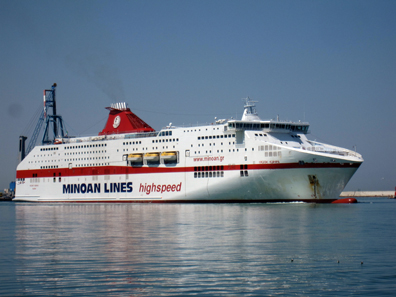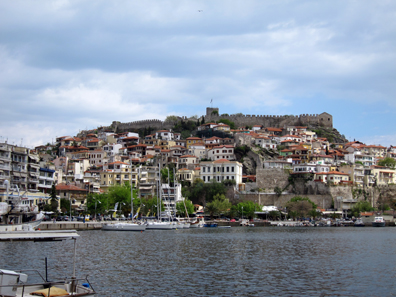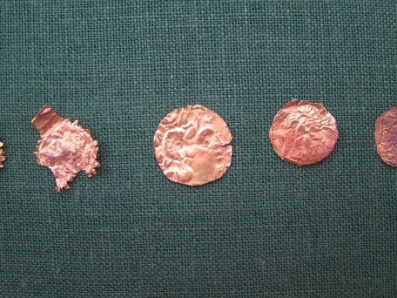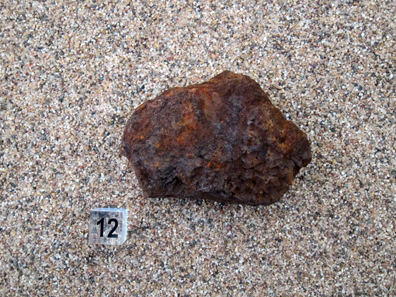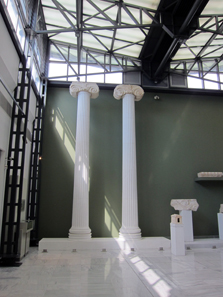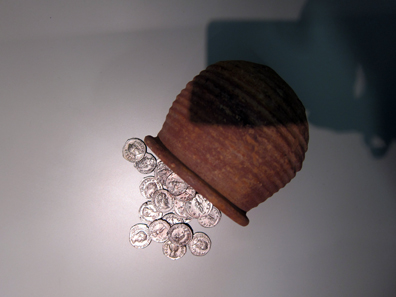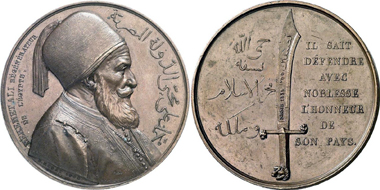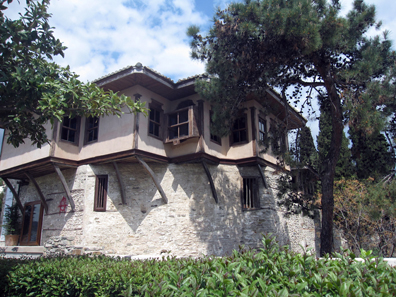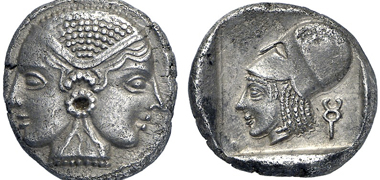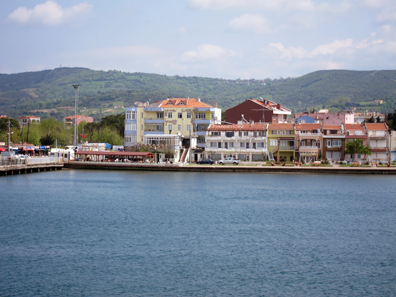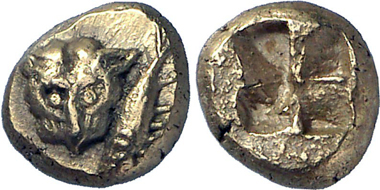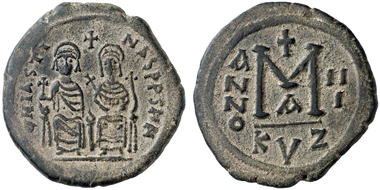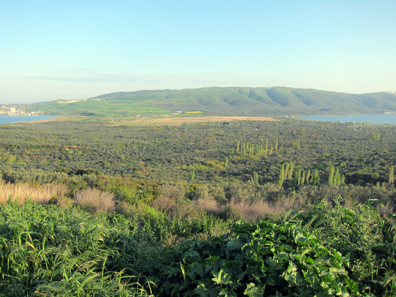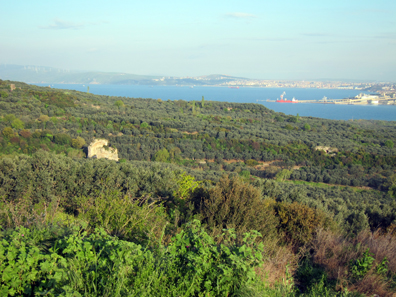by Ursula Kampmann
May 2, 2013 – It’s 2013 and time for another numismatic diary. And, as always, the journey is replete with unexpected things of beauty, but also with mishaps. Part 2 of our trip sees us crossing Greece, ferrying over to Asia, and coming up empty handed in our search for Lampsacus and Cyzicus.
Wednesday April 17, 2013
It was hard to leave homey, inviting Bolzano. But our cabin for the ferry ride from Ancona to Igoumenitsa was already booked. Just how long we’d need, though, to get from Bolzano to Ancona, varied depending on what or whom you consulted – Google maps recommended allowing 4 hours and 20 minutes. The people in Bolzano told us that one should usually budget 6 hours; and that wasn’t even taking into account any possible accidents along the route, a frequent occurrence, by all accounts … In the hotel, a Michelin map was consulted which said it would take a good five hours. So we were left to choose which version to believe.
I’ve always been one to err on the side of caution, and so we set off early at 7:00 am – a truly ungodly hour for vacation!
Kudos is definitely due to the Hotel Scala-Stiegl, who – despite the early hour – still provided us with a large breakfast (and suitably strong espresso).
In retrospect of course, there was no need for such an early departure. We made it to Ancona in record time.
From Ancona to Igoumenitsa with Minoan Lines. Photo: KW.
Everything was impressively well organized at the ferry terminal in Ancona … that is, at least, until it came time for the cars, campers and trucks to be stowed away! ‘Venga! Venga! Venga!’ With a loudspeaker and emphatic gestures, a young Italian attempted to point out precisely where the intimidated drivers were to stop their cars – and pronto. I watched him with amusement. He could sense he was being watched and beamed at me: ‘È una guerra psicologica!’ (It’s psychological warfare!)
The ferry ride lasted about 20 hours. It was a lovely trip. The ferry was practically empty and almost completely devoid of tourists. The cars with German plates could be roughly divided into two groups: those that were completely full – Turkish people on their way to visit relatives, and empty – used cars that were being transferred eastwards by Serbians, Bulgarians and Romanians.
We arrived in Igoumenitsa around 11:00. The new highway on the route of the old Via Egnatia brought us to Kavala, so, into ancient Neapolis, in about four hours. We already had a sort of ‘regular’ hotel there, one that we’d discovered on our first trip to Greece. On our second trip in 2011 we had stayed there for the second time. And now we wanted to stay overnight again. We were extremely lucky: The old grandmother just happened to be in the hotel finishing things off for the start of the season. Otherwise, the house would still have been closed. Tourists at this time! Clearly this was not expected. The restaurants seemed to feel much the same way – there was nothing open in the immediate vicinity. And so, we went to bed hungry, stomachs rumbling.
View of Kavala. Photo: KW.
Thursday April 18, 2013
Up till now, the days had been pretty hectic, so we decided to indulge in our first day off. Although that depends on your idea of a day off … In any case, we left the car and took the bus to Kavala. It was pretty exciting too, especially when we realized shortly after getting off that we didn’t know either the name of the bus stop that we needed to get back or the name of the small suburb where our hotel was. But regardless, we still had a few hours before we had to go back, and by then, everything would surely have worked itself out. (And it did too. We went to the tourist information centre and they had brochures from our hotel where we were able to find the address.)
We had already been to Kavala, the ancient Neapolis, and its surrounding area back in 2011. But until now we had never managed to pay a visit to the archaeological museum.
A look at one of the museum halls. Photo: KW.
At the museum, they were also fairly surprised to see tourists. We were the only visitors. They even turned on all the lights, just for us! The museum was brand new. A new wing had been added, such that the building seemed oversized in comparison to the exhibits. Either way, some of the halls were excellent and amazingly labelled and arranged with an exhibit on the history of Neapolis. The other halls seemed more haphazard.
Hellenistic gold foil in coin form. Photo: KW.
At the entrance were several display cases with interesting objects – with only a rudimentary description and, sadly, without indications as to where they were found. The material itself was still very worth seeing though, like these small gold plates with coin designs. They were likely placed in the mouths of the dead as a contribution for the Ferryman, Charon.
Necklace with coin-shaped pendants. Photo: KW.
Looking to the left of the same display cabinet, one wondered whether this could actually be the case – there, similar coin foils were equipped with eyelets and used as pendants.
Ancient small powder box. Photo: KW.
I especially liked this antique powder box with sponge, which had been finished in leather for easier handling. There was probably even some powder residue in the box.
Iron slag with gold particles. Photo: KW.
As a sort of introduction to the history of Neapolis, the exhibition presented several minerals and slags that were supposed to represent the gold mining in the area. Colonists from Paros had established a settlement on Thasos to control the local gold mining. Naturally, they also set their sights on the precious metal deposits on the mainland, where local tribes were none too thrilled to share their mines with the newcomers.
Parian vessel, 650-600 BC. Photo: KW.
In any case, Parian-style vessels offer evidence that by the middle of the 7th century BC, the new settlers must have been in the area of Neapolis.
Remains of the temple of the Athena Parthenos. Photo: KW.
The biggest hall was dedicated to the remains of the temple for Athena Parthenos. Archaeologists believe the small temple model was used as a container in which the money donated by temple worshippers was kept.
Coin display. Photo: KW.
There were also coins on display, but it was mostly electrotypes.
Small hoard. Photo: KW.
There was a small original hoard of 55 denarii and antoninianii dating back to the time of Gordianus III. It turned up in the city centre of Kavala.
Statue for Mehmed Ali, Viceroy of Egypt. Photo: KW.)
Of course the archaeological museum isn’t the only treasure that Kavala has to offer. The birthplace of Mehmed Ali is also here. Mehmed Ali was the son of a rich Albanian family who, in service to the Ottoman sultan, rose all the way to Viceroy of Egypt and founded a dynasty.
Mehmed Ali was born in 1769. At the time, the military offered him the best opportunities, and so he entered into the service of the Ottoman sultan, where he distinguished himself in battle against Napoleon in Egypt. For this, he received a high command, which he exploited in 1805 to seize Cairo during a dispute between Mamluks and Ottomans. Initially, Mehmed Ali cooperated with the Mamluks, but in 1811, he ordered the extermination of the old Egyptian military cast at the hands of his loyal Albanians. About 1,000 Mamluk traditionalists lost their lives, paving the way for the development of effective administration and the modernization of the country.
Mehmed Ali. Bronze medal 1271 H. (1855) of the laying of the first stone of the Saidjeh fortress on the Nile for the birthday of the Viceroy. Gorny & Mosch 172 (2008), 6571.
Mehmed Ali put major infrastructure programs into place. He sent Egyptians to Europe to learn how to organize agriculture and industry using the latest methods. Overall, by 1821 he had increased Egypt’s public revenue by more than fivefold. The military was also reorganized, and Mehmed Ali became the military arm of the Ottoman Sultan. Under his order, Ali fought against the many enemies of the empire until he was denied a promised promotion of rank. He took this as an opportunity to annex large parts of the disintegrating empire himself: Palestine, Syria, advancing as far as Anatolia.
Mehmed Ali. Bronze medal, 1839 of his victory as Viceroy of Egypt over the Sultan in Nessib. Gorny & Mosch 172 (2008), 6502.
In 1839, the Egyptian troops defeated the Ottoman army. Mehmed Ali could have conquered Constantinople had the major European powers been willing to welcome a non-weak Ottoman ruler. Mehmed Ali had to vacate his conquests and open Egypt up for European investors. For this he was recognized as heritable Viceroy in Egypt. He died in 1849. His dynasty ruled until 1914, when the British deposed the last Egyptian Viceroy.
Birth place of Mehmed Ali in Kavala. Photo: KW.
In Kavala, you can pay a visit to the birthplace of this interesting man.
A look at the men’s lounge. Photo: KW.
This gives you a good idea of how a rich family lived in the Ottoman Empire in the middle of the 19th century.
And with that, we’d had enough for now. We looked for the restaurant with the most Greeks eating in it and found a wonderful place that helped us forget about the previous day’s meagre dinner. The number of starters on offer was downright massive – and compared to other patrons, our selection was modest. At the next table, the waiter brought over dish after dish – fried zucchini, marinated squid, red turnip salad, eggplants in red sauce, fried sardines, baked mussels, spinach, crab, stuffed octopus, plus plus plus …
It’s quite remarkable to note just how much food and eating reflect a culture’s way of life – can you imagine having communal plates where everyone at the table helps themself in somewhere like Germany or Switzerland? For us, it’s considered super generous just to split the bill equally after a meal, regardless of what people ordered. In Greece, on the other hand, people fight over the honour of who gets to pay the bill …
Friday April 19, 2013
And today we were off again, to Turkey. After about two hours, we’d made it to the border. I have to admit, we acted a bit naively, but it’s just that we’re not used to borders anymore, especially those that you cross by car.
I had read that the vehicle is registered in the owner’s passport. And so I held my passport, vehicle papers and green insurance card under the nose of the first official I saw at the border. Quite unnerved, he handed everything back to me and waved us on. We had made it through the Greek border control and left the country.
We drove further into a no-man’s-land. Here, there was a gigantic shopping centre and a huge gas station where you could fill up duty-free – so we could have spared ourselves the desperate search for a gas station that was open in Greece.
We crossed a bridge watched over by armed Greeks and Turks who gave us a friendly wave as we passed. And with that, we were finally in the Turkish border area. There were four sections that had to be mastered here. To start with, the first officer checked our passports and waved us on. Then we waited patiently to have the car registered in the passport. For this, elaborate car registration documents and green insurance cards were checked on the Internet and carefully documented. Next was a (for us) rather cursory luggage check. But for this, you first had to get an inspector’s attention. Anyone too shy would easily have stood around there for a couple of hours. The young man ordered us to open the suitcase. He reached under the clothes, fished out my tea filter, and had to laugh when he realized what it was he had made out to be dangerous goods. He put his checkmark in our passports so we could move onto the last station, where an officer inspected all the notes in all passports and only opened the gate when everything was actually in place.
Ferry across the Dardanelles at Gelibolu. Photo: KW.
And with that, we were in Turkey. And right away, you could tell things were different … The road was now worse. There was a lot more traffic. We saw farmers in the fields and thousands of gas stations. Turkey would appear to have the densest network of gas stations I’ve ever seen in my life. At Gelibolu (from Kallipolis, i.e. the beautiful city) we drove across the entrance to the Dardanelles towards Lampsacus. We were travelling over a deeply historical area – in 405 BC, very close to here, was the sea battle of Aigospotamoi, in which the Spartans defeated the Athenians, thus deciding the Peloponnesian War in their favour.
Lampsacus (Mysia). Stater, End of the 6th / beginning of the 5th century BC. Gorny & Mosch 199 (2011), 355.
Our destination port was Lampsacus – yes, that Lampsacus to whom we owe the splendid gold staters featuring the forepart of a horse …
Lampsacus (Mysia). Drachm, ca. 500-450. Gorny & Mosch 211 (2013), 301.
… and the magnificent silver drachms featuring the female double-headed figure on the obverse.
View of Lampsacus? Photo: KW.
Of course we wanted to see what Lampsacus looks like today. We eagerly looked for the excavation, only to find after half an hour that our ferry had brought us not to Lampsacus, but to Cardak. And so we turned back in search of the ancient Lampsacus. And then we turned around again. And once more. But even though our circles became more and more contained, there was no longer any excavation or any wall remains to be seen in Lampsacus. Instead, what we found was a very lively place that was anything but an ancient provincial town, something that we could have found out in advance, of course, with a little timely reading of a guidebook …
We drove on, somewhat frustrated – past Can Cay, the ancient Granicus, where Alexander, named the Great, fought his first battle against the Persians at what is now current-day Biga. There was nothing to indicate that this had happened here, of course. Not even a sign … Turkey seems to have their own take on such things. There are signs; they’re just never where you might need them. We wanted to spend our first night on Asian soil in ancient Cyzicus. Our first attempt to get to the peninsula in the Sea of Marmara failed miserably – we drove through adventure-filled streets through an extremely authentic original village – dilapidated wooden houses, chickens in the street, awe-struck men in the street cafes – only after about an hour and a lot of cold sweat to get to a roadblock that indicated there was no going any further. A sign at the beginning of this route, perhaps, would have been appreciated. And so, we headed back the way we came, about another hour, and made a second attempt on another route. This time it worked! We made it to Erdek, the centre of Turkish tourism on the Sea of Marmara.
The height of Turkish luxury: Hotel Agrigento in Erdek. Photo: KW.
First, we wanted to look for somewhere to stay. Somewhat surprisingly, we found that the countless hotels were all closed. But what luck! The Hotel Agrigento, described in our guidebook as ‘modern and comfortable,’ was open. There were at least 3 tour buses in front of it, the occupants of which were all crowding around the reception trying to get their room keys.
The lobby was truly worth seeing. Never in my life had I seen so much kitsch concentrated in one place. After trying for about 45 minutes to get the attention of someone in charge, we gave up. There was no way this could be the only hotel open in Erdek.
And of course it wasn’t. There was just one other one in the entire area, and it was called Hotel Helin. It was open, but in dire need of renovation. But for a place to sleep, it would do. We wanted to see Cyzicus!
Cyzicus (Mysia). 1/12 stater, 550-500. Panther head, rev. tuna. Gorny & Mosch 199 (2011), 337.
Cyzicus was founded in 756 by Greek colonists from the city of Miletus. Anyone who has seen the area knows that the city was always destined to become an important trade city. It’s little wonder that two Cyzicans are said to have discovered the direct sea route from Egypt to India. The city’s currency, the Cyzicenes, made of electrum, circulated throughout the entire Black Sea region. This area was extremely important for Greek trade, as it was here that the grain supplies arrived for major cities like Athens. In peacetime, slaves were also procured from the northern Black Sea region, and it was the slaves who kept the ancient economy going.
During the Hellenistic era, it was the Seleucids who first controlled the settlement before it came into the sphere of influence of the Attalids. It ultimately lost its freedom under Augustus.
Iustin II, 565-578 AD. 40 nummi, 567/8, Cyzicus. Gorny & Mosch 212 (2013), 3120.
In 670 the Arabs briefly conquered Cyzicus in order to conduct their capture of Constantinople from there. It was only Iustinian II who first managed to again bring the city under his control. In 690, he undertook a forced relocation of Cypriots to Cyzicus.
In the Early Middle Ages, the region suffered a series of earthquakes, a factor that likely led to the city having been gradually vacated ever since the 11th century.
This is where Cyzicus is supposed to be. Photo: KW.
We knew very well that we weren’t going to get to see that much in Cyzicus. ‘Ultimately, the sparse remains of ancient Cyzicus will only be of interest to archaeological specialists,’ said our guidebook. All the same, I did want to consider myself an ‘archaeological specialist.’ But despite the specialization, I’m still no psychic. A small clue or sign pointing to any remains at all would have been extremely useful. Even just a tiny one! But no, nothing. We drove around the dirt roads for about two hours looking for anything that might seem potentially suspicious.
Cyzicus? Photo: KW.
To make a long story short, we found nothing that was worthwhile. And we felt quite foolish as well, since we knew those stupid ruins had to be somewhere just around the next corner!
Disappointed, we drove back to the hotel, only to find that it had been taken over by four buses full of Turkish tourists. They were in the lobby, the dining rooms and the patio. And after a short, fruitless search to find something to eat, we decided that a little fast would certainly do us no harm. We went back to the room, where the bed was more like a baggy hammock. What followed was a restless night and the resolution never again to return to Cyzicus.
Well, it wasn’t exactly the depths of despair … more like a temporary hiccup. The next leg of our Turkey journey will take us to a little bit of paradise – into Troas, and the undeservedly but still largely unknown Assos.
All parts of the series ‘Springtime in Turkey’ can be found here.




